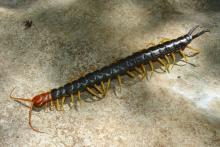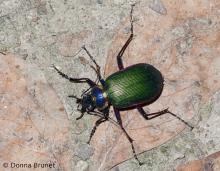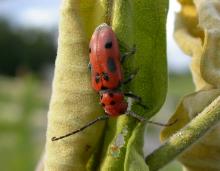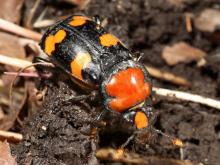Land Invertebrates
Media

Species Types
Scientific Name
Scolopendra heros
Description
The bright colors of the giant redheaded centipede have a message for you: Handle with great care! It’s of the few centipedes in our state capable of inflicting a painful, venomous bite.
Media

Species Types
Scientific Name
Nearly 200 species in North America north of Mexico
Description
Assassin bugs are usually black or brown, with an elongated head bearing a single, clawlike tube used for piercing and injecting venom into their prey. They are common in Missouri.
Media

Species Types
Scientific Name
Syrbula admirabilis
Description
Although they both have slanted faces, male and female admirable grasshoppers look quite different: The females are large and marked with bright green and tan, and the males are smaller and wear brown, black, and tan hues.
Media

Species Types
Scientific Name
Arilus cristatus
Description
The wheel bug is a large gray or brown insect that carries something interesting on its back: Is it a cog, or a wheel, or a circular saw blade?
Media

Species Types
Scientific Name
More than 5,000 species in North America
Description
Most ichneumon wasps are harmless, although the long ovipositor of the female is intimidating. Their larvae live as parasites inside caterpillars and other larval insects.
Media

Species Types
Scientific Name
About 2,400 species in North America north of Mexico
Description
Ground beetles are a family of mostly nocturnal or light-shunning beetles that tend to be shiny black and have grooved wing covers. This group also includes tiger beetles, however, which includes many colorful daytime fliers.
Media

Species Types
Scientific Name
About 1,000 species in North America north of Mexico
Description
Longhorned beetles are elongated and cylindrical, with antennae that are at least half the length of the body — sometimes much longer. The larvae are grubs that bore in wood or other plants. Some are serious pests.
Media

Species Types
Scientific Name
Ammophila spp.
Description
There are more than 60 species of ammophila wasps in North America. They tend to be black, with orange on the abdomen. They are but one genus in the thread-waisted wasp family.
Media

Species Types
Scientific Name
About 300 species in North America north of Mexico
Description
People notice spider wasps when they notice a female lugging a captured spider to its doom. In most cases, she will drag the spider into a burrow, lay an egg on the spider, and then hunt for more spiders!
Media

Species Types
Scientific Name
Nicrophorus americanus
Description
The American burying beetle is endangered statewide and threatened nationally. Restoration efforts are under way. This brightly patterned beetle specializes in cleaning carrion from the landscape, burying dead mice, birds, and other creatures.
See Also



Media

Species Types
Scientific Name
Cisseps fulvicollis
Description
The yellow-collared scape moth is more often “orange-collared.” And whether you think it looks more like a firefly or a wasp, it’s still a moth!
Media

Species Types
Scientific Name
Nearly 150 species in North America north of Mexico
Description
Slim, delicate plume moths are instantly recognizable by their T-shaped silhouette, long legs, and muted shades of tan and brown. It can be hard to separate the various species.
Media

Species Types
Scientific Name
Pyrrharctia isabella
Description
Not many people know the adult Isabella tiger moth when they see one, but we’re all acquainted with its caterpillar, the woolly worm, or woolly bear.
About Land Invertebrates in Missouri
Invertebrates are animals without backbones, including earthworms, slugs, snails, and arthropods. Arthropods—invertebrates with “jointed legs” — are a group of invertebrates that includes crayfish, shrimp, millipedes, centipedes, mites, spiders, and insects. There may be as many as 10 million species of insects alive on earth today, and they probably constitute more than 90 percent all animal species.





















